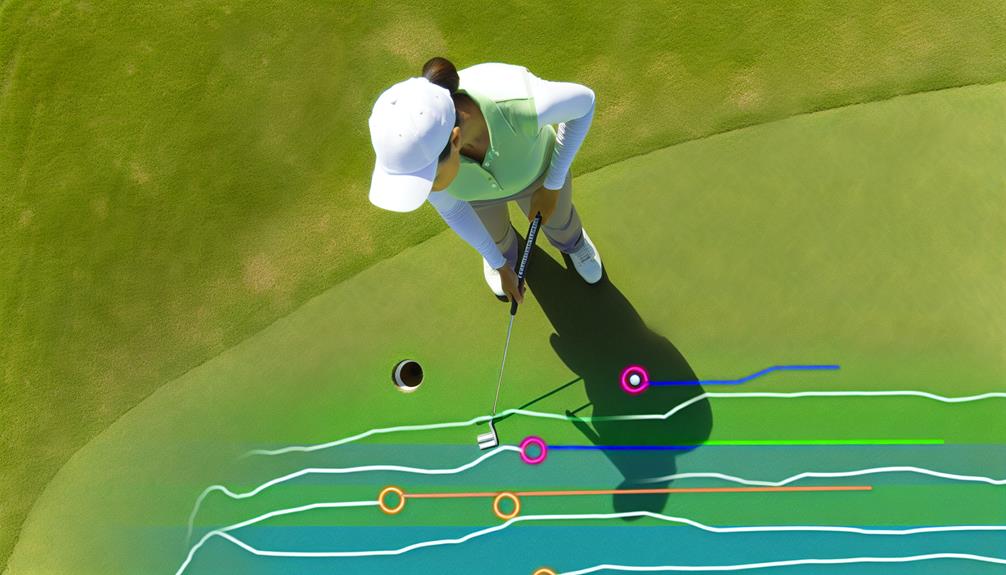Imagine you're standing on the 18th green at Augusta National, with the chance to secure the Masters with a challenging 60-foot putt. You're confident, yet aware of the intricacies of the task at hand.
Long putts are often the game changer in golf, requiring a unique blend of precision, control, and strategic insight. But, what if you could turn these daunting long putts into an opportunity rather than an obstacle?
This guide will provide you with effective strategies to master the art of long putts, transforming you into a more skilled and strategic golfer. Yet, it's not just about learning the strategies; it's about understanding why they work, which we'll explore further.
Understanding the Basics of Long Putts
Mastering the art of long putts hinges on your understanding of their basic principles, including distance control, reading the green, and the proper execution of your stroke. This understanding starts with Putt Psychology; your mindset, focus, and confidence play a pivotal role in your performance. You're not just aiming to get the ball in the hole; you're strategizing a path, envisioning the ball's journey, and executing with precision.
Equipment selection is another cornerstone. The right putter can drastically enhance your performance. When choosing, you must consider the putter's length, weight, and design. The wrong putter can lead to poor alignment or inconsistent strokes, both nightmares in long putts.
Next comes distance control. You've to gauge the force needed to cover the distance but also counteract the green's slope and speed. Reading the green, therefore, is critical. It's about understanding the terrain, factoring in the grass type, moisture level, and gradient.
Finally, your stroke execution. It's not about power, but rhythm and consistency. From the backswing to the follow-through, each element of your stroke contributes to the putt's outcome.
In essence, long putts require a combination of psychology, equipment selection, distance control, reading the green, and stroke execution.
Importance of Correct Posture
Have you ever considered how crucial your posture is when executing a long putt? It's more significant than you might realize. The right posture can be the difference between sinking that crucial birdie and missing your shot entirely.
Posture consistency is a key factor in successful long putting. Your stance should be the same every time you line up a shot. This repetition helps ingrain the correct movements in your muscle memory, leading to more accurate and consistent putts. Don't underestimate the value of practice here – it's through repetition that you'll find the stance that works best for you.
The significance of balance can't be overstated either. A stable, balanced stance provides the foundation for your swing. If you're off balance, your putt's direction and speed could be off too. Try to distribute your weight evenly between your feet and keep your body still during the stroke.
Techniques for Assessing the Green
When you're sizing up a long putt, accurately reading the green plays a pivotal role in determining the success of your stroke. Green reading isn't just about observing, it's about interpreting. Start by walking around the hole, seeking the subtle undulations that could influence the ball's path.
Next, you'll delve into slope analysis. Stand behind the ball to get a clear view. Visually determine the highest and lowest points around the hole. The ball will always tend to move from high to low. Look for the overall tilt of the green, as this will influence the ball's speed and direction. Additionally, note the grass type and length, as these can also affect the ball's roll.
Don't forget to consider the weather. Wet greens slow the ball down, while dry conditions can speed it up. Wind direction can subtly alter your putt's path, too.
Mastering the Stroke for Long Putts
Once you've accurately read the green, it's essential to focus on perfecting your stroke for those lengthy putts, ensuring precision and control in each swing. Grip control is a fundamental aspect of this process. Your grip should be firm but relaxed, allowing for a smooth, steady stroke. Your wrists shouldn't be too tense or too loose, but just right, to maintain a good pendulum motion.
Remember, the length of your stroke should correlate with the distance of the putt. Stroke variations are crucial here. For long putts, a longer, slower stroke is often more effective, whereas a shorter, faster stroke can create too much momentum, causing the ball to overshoot the hole. Your backstroke and follow-through should be equal in length and speed, promoting consistency and accuracy.
Working on your grip control and stroke variations will significantly improve your long putting game. However, it's not just about practicing these techniques; it's about understanding them and knowing when to apply each one. This analytical approach to your stroke will provide you with the necessary tools to master those lengthy putts and, ultimately, lower your overall score.
Practice Routines for Long Putt Proficiency
To boost your proficiency in long putts, it's vital to establish a dedicated and systematic practice routine, specifically tailored to improving your grip control, stroke variations, and distance judgement. A well-aligned routine not only enhances your skills but also builds a solid foundation for confidence.
Begin with Putt Visualization. Picture the ball's path, visualize its speed, and focus on its landing spot. This mental exercise primes your brain for the actual execution. Repeat this visualization until it's engraved in your subconscious. It's a powerful tool that translates your mental projection into physical reality.
Next, invest time in Confidence Building. Confidence in long putting often stems from repeated success in practice. Start with shorter putts, gradually increasing the distance. This incremental progression provides a series of small victories, reinforcing your belief in your abilities.
Lastly, record your practice sessions. Analyzing these recordings allows you to identify and correct any flaws in your stroke or grip. It's also a great way to measure progress over time.

